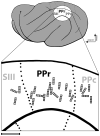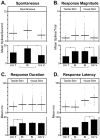Multisensory and unisensory neurons in ferret parietal cortex exhibit distinct functional properties
- PMID: 23279600
- PMCID: PMC3604143
- DOI: 10.1111/ejn.12085
Multisensory and unisensory neurons in ferret parietal cortex exhibit distinct functional properties
Abstract
Despite the fact that unisensory and multisensory neurons are comingled in every neural structure in which they have been identified, no systematic comparison of their response features has been conducted. Towards that goal, the present study was designed to examine and compare measures of response magnitude, latency, duration and spontaneous activity in unisensory and bimodal neurons from the ferret parietal cortex. Using multichannel single-unit recording, bimodal neurons were observed to demonstrate significantly higher response levels and spontaneous discharge rates than did their unisensory counterparts. These results suggest that, rather than merely reflect different connectional arrangements, unisensory and multisensory neurons are likely to differ at the cellular level. Thus, it can no longer be assumed that the different populations of bimodal and unisensory neurons within a neural region respond similarly to a given external stimulus.
© 2012 Federation of European Neuroscience Societies and Blackwell Publishing Ltd.
Conflict of interest statement
Declaration of interest: The authors report no conflicts of interest. The authors alone are responsible for the content and writing of the paper.
Figures








Similar articles
-
Laminar and connectional organization of a multisensory cortex.J Comp Neurol. 2013 Jun 1;521(8):1867-90. doi: 10.1002/cne.23264. J Comp Neurol. 2013. PMID: 23172137 Free PMC article.
-
Do cross-modal projections always result in multisensory integration?Cereb Cortex. 2008 Sep;18(9):2066-76. doi: 10.1093/cercor/bhm230. Epub 2008 Jan 17. Cereb Cortex. 2008. PMID: 18203695 Free PMC article.
-
Development of multisensory processing in ferret parietal cortex.Eur J Neurosci. 2023 Sep;58(5):3226-3238. doi: 10.1111/ejn.16094. Epub 2023 Jul 15. Eur J Neurosci. 2023. PMID: 37452674 Free PMC article.
-
Where are multisensory signals combined for perceptual decision-making?Curr Opin Neurobiol. 2016 Oct;40:31-37. doi: 10.1016/j.conb.2016.06.003. Epub 2016 Jun 23. Curr Opin Neurobiol. 2016. PMID: 27344253 Review.
-
Are Bimodal Neurons the Same throughout the Brain?In: Murray MM, Wallace MT, editors. The Neural Bases of Multisensory Processes. Boca Raton (FL): CRC Press/Taylor & Francis; 2012. Chapter 4. In: Murray MM, Wallace MT, editors. The Neural Bases of Multisensory Processes. Boca Raton (FL): CRC Press/Taylor & Francis; 2012. Chapter 4. PMID: 22593892 Free Books & Documents. Review.
Cited by
-
Laminar and connectional organization of a multisensory cortex.J Comp Neurol. 2013 Jun 1;521(8):1867-90. doi: 10.1002/cne.23264. J Comp Neurol. 2013. PMID: 23172137 Free PMC article.
-
Resting state network topology of the ferret brain.Neuroimage. 2016 Dec;143:70-81. doi: 10.1016/j.neuroimage.2016.09.003. Epub 2016 Sep 2. Neuroimage. 2016. PMID: 27596024 Free PMC article.
-
Multisensory-inspired modeling and neural correlates for two key binocular interactions.Sci Rep. 2024 May 17;14(1):11269. doi: 10.1038/s41598-024-60926-6. Sci Rep. 2024. PMID: 38760410 Free PMC article.
-
Oscillatory Dynamics in the Frontoparietal Attention Network during Sustained Attention in the Ferret.Cell Rep. 2016 Sep 13;16(11):2864-2874. doi: 10.1016/j.celrep.2016.08.055. Cell Rep. 2016. PMID: 27626658 Free PMC article.
-
Effects of developmental alcohol exposure on cortical multisensory integration.Eur J Neurosci. 2023 Mar;57(5):784-795. doi: 10.1111/ejn.15907. Epub 2023 Jan 24. Eur J Neurosci. 2023. PMID: 36610022 Free PMC article.
References
-
- Alais D, Newell FN, Mamassian P. Multisensory processing in review: from physiology to behaviour. Seeing Perceiving. 2010;23:3–38. - PubMed
-
- Allman BL, Meredith MA. Multisensory processing in “unimodal” neurons: cross-modal subthreshold auditory effects in cat extrastriate visual cortex. J Neurophysiol. 2007;98(1):545–549. - PubMed
-
- Amassian VE, Devito RV. Unit activity in the reticular formation and nearby structures. J Neurophysiol. 1954;17:575–603. - PubMed
Publication types
MeSH terms
Grants and funding
LinkOut - more resources
Full Text Sources

